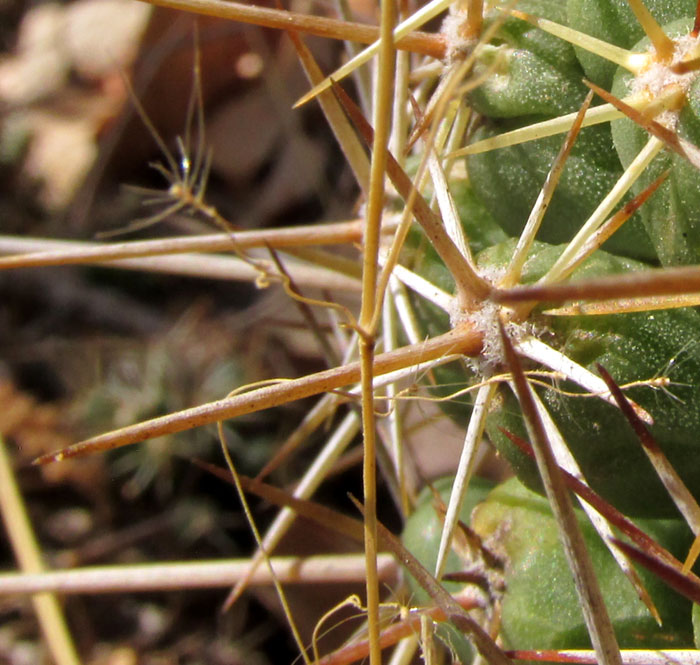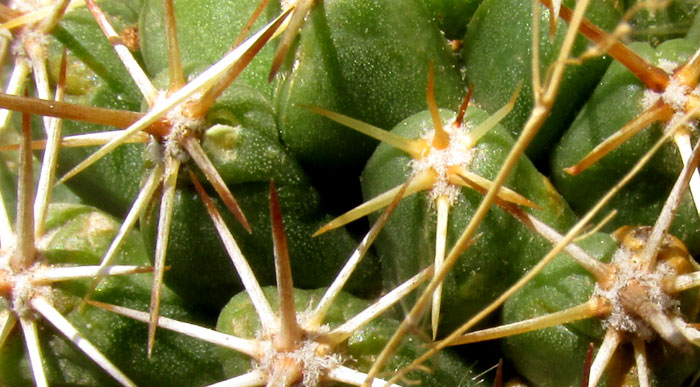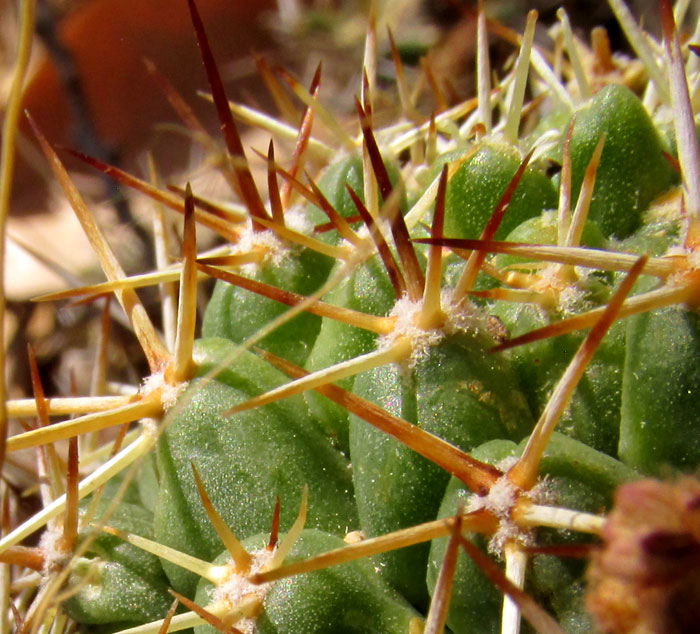Excerpts from Jim Conrad's
Naturalist Newsletter
entry dated May 18, 2022, notes from a camping trip among hills about 7kms ENE of Tequisquiapan, Querétaro state, MÉXICO
elevation about 2020m (6600 ft), near N20.57°, W99.85°
"BEEHIVE" CACTUS

Beneath an isolated, late-dry-season leafless Mexican Oak tree on rocky, grassy slopes, the above small cactus looked like it was having a hard time, almost dried-up and dead. However, the more I looked at it, the more I suspected that this was the normal appearance, at least in its natural environment.
Note that the green, spiny, ball-shaped part of the cactus doesn't immediately arise from the ground, but is just the tip of a long, thick, dead-looking stem wandering across the ground. If you look closely at the "dead part," though, you see that here and there parts look only half dried-up, and the whole brown trunk looks like it was once covered with green, spine-bearing parts. Here's a close-up of the spherical, green tip of the cactus:

You can see that the body, instead of consisting of vertical ribs atop which clusters of spines arise, as with many cactus types, this one is composed of rounded peaks, or "tubercles," with spines radiating from spots known as areoles atop each tubercle.
Below is a close-up of a tubercle with its areole and spine cluster. Note that the areole's surface is densely carpeted with woolly white hairs.

The best known type of this kind of ball-shaped, tubercle-producing cactus -- much-commercially-sold in pots and as desert garden plants -- are species known as "pincushion cacti" or "nipple cacti," genus Mammilllaria. However, I'd never seen any Mammilllaria growing from a long trunk like this. Here was something different.
If you have a cactus with its body covered with round-topped, chili-pepper-green tubercles, and at the base of the tubercle-top areole with its cluster of radiating spines and white-woolly surface there's a shallow groove, a good bet is that you have the genus Coryphantha. Below, especially in the picture's upper-right corner, you can see a shallow groove, and atop other tubercles sometimes you can make out grooves also.

So, genus Coryphantha. Sometimes the 57 or so Coryphantha species are called beehive cacti because some people imagine that that's what the green part more or less looks like.
Species in the genus Coryphantha can be neatly divided into two groups: One group bearing "extrafloral nectaries," and the other without them. Extrafloral nectaries are glands providing nectar for animals, with the glands located elsewhere than in the flowers. The question is, does our ground-lying species produce nectaries and, if so, what do they look like?
In 2016, James Mauseth and others published the article "Extrafloral nectaries in cacti," in which it's stated that among cacti at least four morphologically different types of extrafloral nectaries are produced. Among those four kinds, certain species of the genus Coryphantha exhibit glands that are "Highly modified spines that are short, broad and blunt." Pictures of this type of gland appearing on species not in the genus Coryphantha show objects looking like small buttons or knobs at the base of each areole.
In the above picture, I'm guessing that in the lower, right corner, the yellow, callus-like item is a nectary. Other tubercles in the picture appear to bear less developed ones, especially the tubercle more or less at center-left in the picture.
Another detail to notice about our cactus is that some of the spines have dark brown tips:

All the above features, especially the long trunk, take us to CORYPHANTHA OCTACANTHA, endemic to a small part of semiarid upland central Mexico, in parts of the states of Aguascalientes, Guanajuato, Hidalgo and here in Querétaro, at an elevation of from 1700-2200m (5600-7300 feet). At this writing Wikipedia provides a distribution map. The species is described as occurring in dry scrub and tropical deciduous forests (mesquite, acacia, etc.), and doing best on limestone soils, though here the rocks are mostly volcanic rhyolite.
Coryphantha octacantha is widely sold as a pot and desert-garden plant, and in domestication grows straight up and lacks a dead-looking trunk. However, in the small area over which it's distributed, its habitat is under attack. The soil it grows in is being damaged and destroyed by livestock grazing, traditional yearly burnings of grassy areas, and firewood-gathering/deforestation. And that's not to mention the very active cactus thievery plaguing the entire region.